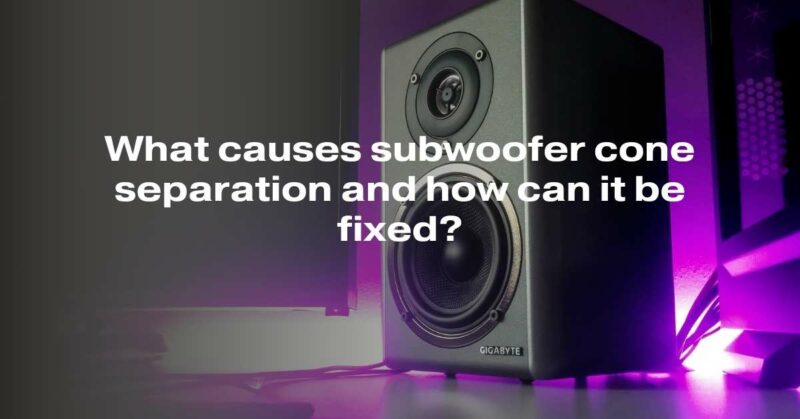Subwoofers are a crucial component in any audio system, providing the deep and powerful bass that can truly enhance your audio experience. However, like any electronic device, subwoofers are susceptible to wear and tear over time. One common issue that subwoofer owners may encounter is cone separation. In this article, we will explore the causes of subwoofer cone separation and provide insights into how this problem can be fixed or prevented.
I. What Is Subwoofer Cone Separation?
Subwoofer cone separation refers to the detachment or loosening of the cone from the subwoofer’s frame. The cone is the large, typically paper or polypropylene surface that moves air to create the low-frequency sound waves responsible for deep bass. When cone separation occurs, it compromises the subwoofer’s performance and can lead to distorted sound or even complete failure.
II. Causes of Subwoofer Cone Separation
Several factors can contribute to subwoofer cone separation:
- Overpowering: Running a subwoofer at power levels exceeding its handling capacity can cause the cone to flex excessively and weaken the adhesive that holds it to the frame. This can lead to separation over time.
- Age and Wear: Subwoofers, like any mechanical device, have a finite lifespan. Over time, the materials used in the cone and the adhesive that bonds it to the frame may degrade, making them more susceptible to separation.
- Excessive Heat: Subwoofers generate heat during operation. If the subwoofer is subjected to prolonged periods of high heat, it can soften the adhesive, making the cone more prone to separation.
- Physical Damage: Accidents or mishandling, such as dropping or bumping the subwoofer, can damage the cone or weaken the adhesive, leading to separation.
- Inferior Materials: Subwoofers of poor quality or with subpar materials may experience cone separation sooner than higher-quality counterparts.
III. Fixing Subwoofer Cone Separation
Fixing subwoofer cone separation is possible, but the extent of the repair will depend on the severity of the issue and your level of expertise. Here are some steps to consider:
- Assess the Damage: Inspect the subwoofer to determine the extent of the separation. If it’s a minor issue, you may be able to fix it yourself.
- Reattach the Cone: If the cone separation is minimal, you can attempt to reattach it using a suitable adhesive. Ensure that the adhesive is designed for speaker repair and follow the manufacturer’s instructions carefully.
- Reinforce with Gauze or Tape: For added strength, you can use gauze or specialized speaker repair tape to secure the cone to the frame. Be cautious not to obstruct the cone’s movement, as this can affect sound quality.
- Consider Professional Repair: If the damage is extensive or you lack experience in speaker repair, it’s advisable to seek professional assistance. A skilled technician can evaluate the damage and perform necessary repairs, including re-coning if required.
IV. Preventing Subwoofer Cone Separation
Prevention is often more manageable and cost-effective than repair. Here are some tips to help prevent subwoofer cone separation:
- Proper Power Handling: Always match your subwoofer’s power handling capacity with an appropriate amplifier. Avoid overpowering, which can stress the cone.
- Regular Maintenance: Inspect your subwoofer periodically for signs of wear, loose parts, or physical damage. Catching issues early can prevent them from worsening.
- Control Temperature: Ensure that your subwoofer is adequately ventilated and not subjected to excessive heat. Proper ventilation can prolong its lifespan.
- Use Quality Subwoofers: Invest in high-quality subwoofers made with durable materials and quality craftsmanship. While they may be more expensive, they tend to have longer lifespans and better performance.
- Handle with Care: Be gentle when transporting and installing your subwoofer. Avoid dropping or subjecting it to physical shocks.
Conclusion
Subwoofer cone separation is a common issue that can impact the performance and longevity of your audio equipment. Understanding the causes and taking preventive measures can help prolong the life of your subwoofer. If cone separation does occur, consider your options for repair, whether through DIY methods or professional assistance, to restore your subwoofer’s functionality and enjoy the deep bass it was designed to provide. Remember that proper care and maintenance are key to preventing cone separation and ensuring a satisfying audio experience.

